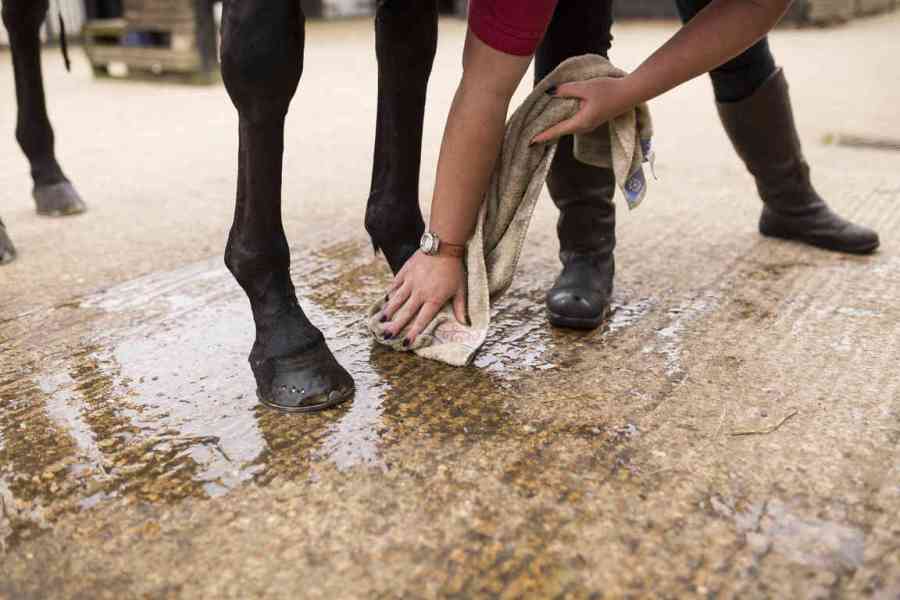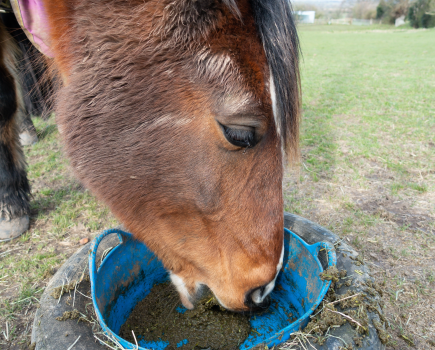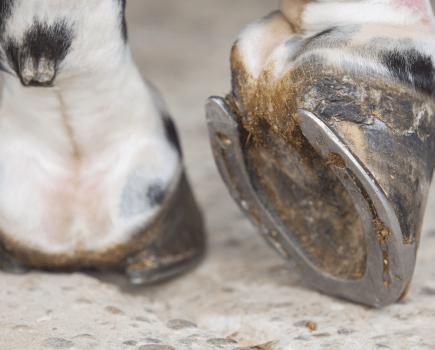No matter how good your horse hoof care is, hoof abscesses can and do happen. A hoof abscess can be incredibly painful and can result in your horse becoming severely lame. Regular farriery for both shod and unshod horses is essential, as your farrier will remove unhealthy hoof tissue and any horn that holds mud in a defect.
Abscesses happen when the horn of the hoof becomes soft, allowing grit to penetrate. Damaged hoof wall, especially associated with the white line, can result in a microscopic entry point for bacteria. Infection sets in and there is a build up of black pus. The hole then closes over and the pus is stuck in the hoof cavity with nowhere to go, causing a painful foot.
Loose and poor fitting shoes are predisposing factors too. Remedial farriery and pads fitted over the sole of the hoof may be required in a horse with weak soles or low heels, who are prone to bruising and punctures.
“Keeping your horse’s feet trimmed and well shod will help to ensure they stay healthy and can reduce the risk of the hoof splitting,” states vet Hazel Clewley. “It’s important to bear in mind that unshod horses can be more at risk to abscesses because their white line is exposed. You could opt for putting shoes on over the wetter months if you’re concerned. Consult your farrier if you’re unsure.”
Preventing a hoof abscess
A hoof that is constantly wet is vulnerable to abscesses because it becomes soft, so sleaning and drying of the whole hoof is essential, especially in wet conditions. Think about the strange ‘wrinkly’ feeling your skin gets if you stay in the bath too long — it’s a similar feeling for your horse if they are stood out in the wet too. Providing dry areas for your horse to stand on, keeping bedding clean and dry through regular mucking out, and picking your horse’s feet out regularly are just a couple of things that you can do to limit the risk of a hoof abscess occurring.
“Good management will go a long way to limiting abscesses, and applying antiseptics on the sole may help too,” says Hazel.
Fellow vet Lucinda Ticehurst adds that antibacterial solutions (for example dilute iodine or eucalyptus oil with iodoform crystals) can be used to kill off any bacteria and can be applied to any defects, soft soles, nail holes or deep heel clefts.
“Hoof oil and creams can also be used to aid hoof quality and should be used to prevent the hoof becoming brittle in very dry conditions,” says Lucinda. “If shoeing is required very frequently, a hoof supplement containing biotin is advised to aid hoof growth so there are fewer nail holes weakening the hoof wall structure.”
Everything your horse stands on affects their feet. Abrasive surfaces should be avoided, as well as soiled bedding, waterlogged areas and large stones, so you may need to change your management depending on the weather and your horse’s hoof quality.
Signs of a hoof abscess
Hoof abscesses can appear as sudden, severe lameness in a horse, with some horses reluctant to put any weight at all on their affected foot. It has been known for many a concerned owner to worry about a broken leg in a horse who is later diagnosed with a hoof abscess, so severe is the pain that it causes.
In other horses, symptoms may be more subtle. Your horse may be lame one day, but not the next. Or you may have felt your horse step on something sharp, like a stone, out riding the previous day and now they are lame, because that sharp object caused a punctured sole. It’s always worth getting your vet out to check their digital pulse and assess any reaction to hoof testers to see whether an abscess, or a bruised sole, is causing problems.
In simple cases, a vet or farrier can find the abscess tract while examining the foot and open it up with a paring knife. This lets the pus drain out through the hole, relieving pressure. You should then apply a hoof poultice to draw out any remaining pus and keep the hoof clean and dry until it heals. If your horse is in a lot of pain, your vet may prescribe a course of bute, but the lameness should soon resolve.
What is a horse’s digital pulse?
A horse’s digital pulse can be felt on both the outside and inside of their leg from just above the fetlock, on the fetlock, and on the pastern. The digital pulse is caused by blood flowing through the artery into the hoof. A digital pulse on a horse with no hoof or lower limb injuries is hard to find, whereas a pulse that is strong and easy to find indicates an injury to the horse’s hoof or lower leg. This is because any inflammation in the leg or hoof restricts blood flow through the artery, thus affecting the digital pulse. It is best to use your index and middle fingers to look for a digital pulse, as you can feel your own pulse through your thumb.
Is a hoof abscess serious?
When vet Steph Cook from Scott Mitchell Associates, a member of Equine XLVets, first met eight-year-old warmblood Daisy, the mare was suffering from severe lameness on her left hind. A hoof abscess was located just below the point of her frog and towards the outside of her foot, but it went rather deep and the mare had an ‘under-run’ sole. An under-run sole is where there’s a separation of the sole between the abscess, and it forms two layers of sole.
“I decided to par her foot out, but Daisy also needed foot X-rays to check how far into her foot the abscess was going,” recalls Steph. “When Daisy came back in for X-rays, I pared out her foot again and there was yet more pus in the hole. X-rays showed a slightly mottled edge to the pedal bone, lying under the area where the abscess was tracking. This showed us that the infection had spread to involve the bone.”
Daisy needed the infected area of bone removed and so her foot was prepared soaking and scrubbing it in iodine.
“She was sedated and an intravenous catheter was inserted so that she could have a constant flow of low-dose sedation to keep her calm, still and sleepy throughout the procedure,” says Steph. “I injected local anaesthetic into a nerve above her foot to prevent Daisy feeling anything during the procedure. We put a catheter into a small vein above her foot and placed a tourniquet above this to stop the blood from her foot going around her body. We then injected antibiotic straight into this vein, to enable a high concentration of the antibiotic to get to where it’s needed and stay there for some time, rather than going around her whole body in her blood stream.”
Sterile hoof poulticing
The site of the hoof abscess was scrubbed to ensure it was sterile, before vets removed the infected area of bone and applied a sterile poultice.
In the days following Daisy’s operation, her poultice was changed daily until the bone had started to granulate (this is where it gets a hardened edge). When this happened, Daisy had normal poultice dressings again without them needing to be sterile, as the bone was healing over. The mare was sent home and her owner continued with the poulticing as normal and kept her in her stable out of the mud.
“I went back to see Daisy a few days later and met with the farrier who placed a shoe on with a sole pad underneath, to protect the hole from getting anything in it and give it cushioning until it completely grows and fills in again. She made a full recovery.”









